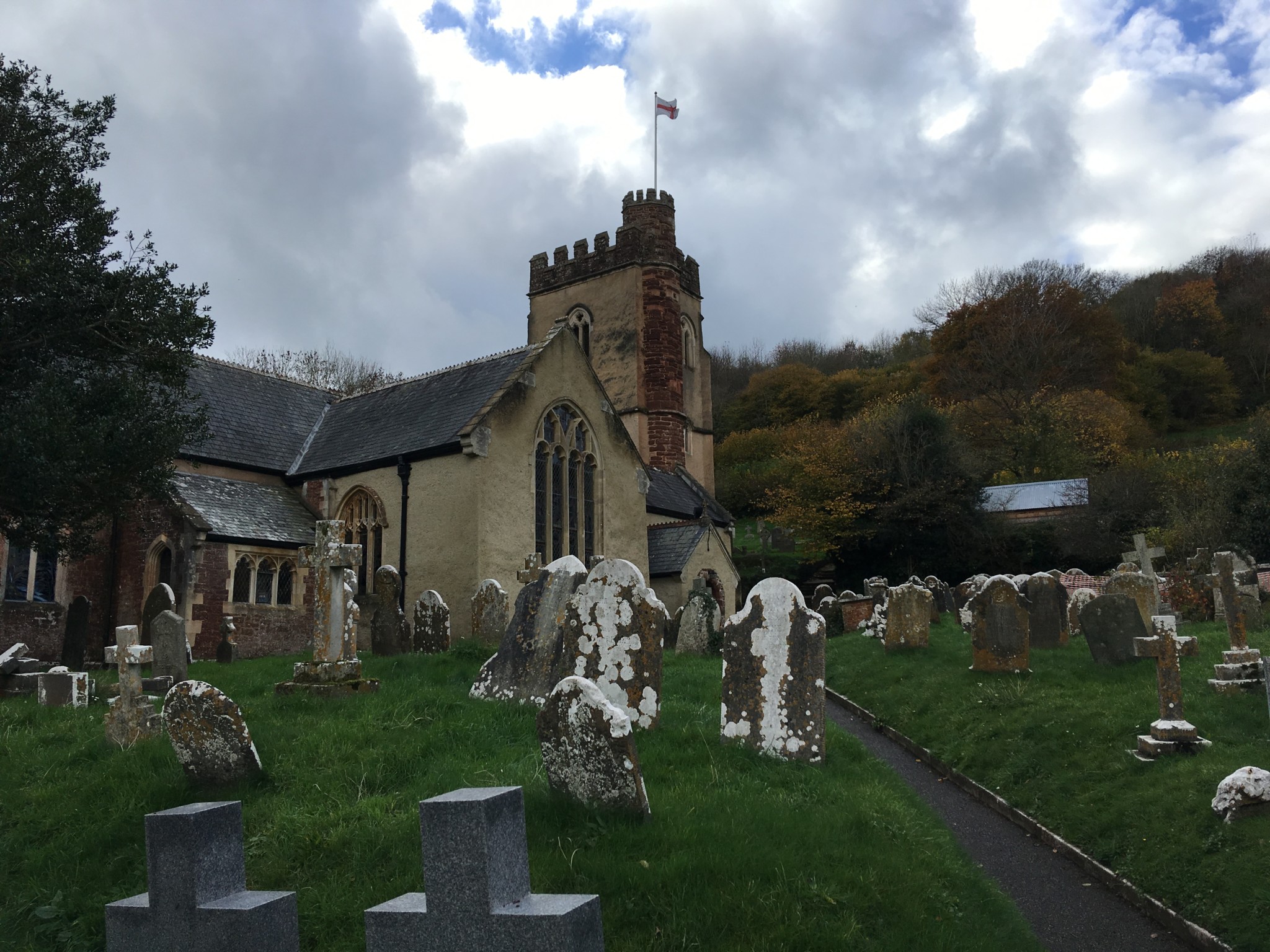Devon, St Andrew Stokeinteignhead
The church of St Andrew at Stokeinteignhead, South Devon, stands slightly above the surrounding cottages on the rising ground of a steep valley, which here widens out sufficiently to allow the formation of a village centre. The setting is constrained by the landscape, so that the relationship between church, church house (now the pub) and potential manor house is still close and largely intact, though the potential manor house, as suggested by the local sites and monuments record, has been downgraded to a barn, and the village green, on which in the 1930’s the locals were still playing bowls, is now the pub car park.
The church is built from the coarse local red sandy breccia, a stone that offers very little scope for the graffiti inscriber, and which tends to weather badly if left un-rendered, effectively obliterating any inscription that might have been left in the past. The bulk of the exterior of the building has consequently been rendered, but fortunately for the graffiti hunter the decorative architectural mouldings are of limestone, and the inner and outer arches of the north porch, plus the inner arch of the former south porch provide a good selection of decorative and apotropaic graffiti.
Pevsner gives St Andrew’s dates of late 14th to 15th century, with a known date of 1867 for the rebuilding of the chancel. The foundation date was presumably before 1375, the date of a brass to a priest re-set in the sanctuary floor and reputed to be the earliest in Devon. The Chancel, which is normally locked, is separated from the body of the church by a large, 14th century, roodscreen – agreeing with the probable 14th century foundation date. The whole building was restored by the Victorians in 1894, at which point the entire inside was scoured back to the local red stone.
The north, main entrance, porch, has a series of score marks on the east side of the exterior arch. Commonly reputed to be places where local bowmen sharpened arrows, or local soldiery sharpened swords, these marks occur regularly around the county on various stone surfaces at building entrances. On close inspection they seem to have little practical use as sharpening aids: the narrow, incised, grooves are not suitable for putting an edge on a blade, and are often on one of the lower stones in a wall. Whether they are apotropaic; whether they ‘inoculated’ a building, or whether they performed a function that ‘improved’ an object applied to them in other ways than sharpening is not yet clear.
The external doorway of the porch is otherwise fairly lightly inscribed with graffiti, the focus of activity on this side of the building being the arch and jambs of the inner doorway. This has, aside from clearly personal initials, a selection of the commonly occurring Marian marks; a slightly off-kilter butterfly mark; a star overlying a small shield and, most interestingly, a series of pentangles running up the arch above the jamb on the western side.
Inside the building the walls have been stripped as part of the Victorian restoration, leaving the white Beer stone capitals perched in an oddly detached manner on top of red breccia pillars. With the exception of one small incised compass drawn circle on the roodscreen, the further area of graffiti is around what was formerly the inner south doorway, now the entrance to a tiny Lady Chapel formed in the old south porch.
The most striking graffito on the south doorway has to be a column of five incised compass drawn circles incorporating a date, 1679, and two initials: a crossed I (J) and a capital G. The graffito is cleanly incised, and visible without specialist lighting, however, once light is used on the door jambs and arch, a complex palimpsest of superimposed marks can be seem, including a number of Marian marks, several initials, and most pleasingly a series of lightly inscribed ships, which appear to lie below the other graffiti, indicating their earlier date.
The final two scraps of graffiti, almost certainly not of a very early date, occur on the jambs of the doorway into the upper part of the tower – AM to the left and PM to the right.
Aside from the brass to the priest in the chancel, there are several ledger stones used as paving, and a number of 19th century monuments to local worthies. Possibly the most interesting monument is an earlier one to Jfet (Iset) Cock, died 1746, set in the south wall. Aside from a trefoil headed piscina in the chancel, there are piscinae in both transepts, indicating the location of former altars, and suggesting a fairly wealthy foundation. Three fragments of medieval glass survive in the south transept.
Church of St Andrew, Stokeinteignhead,
Newton Abbot,
TQ12 4QA
Report by Rebecca Ireland
Search terms: score marks, incised circles, Marian, star, shield, pentagram, crossed I, cross, long-tailed star, butterfly cross, gouges, criss cross, saltire, ship, ships, green man, initials: ibw,p,m,ih,mc,wc,nw,r,e,h,t,k,ip,ea,ir,fr,ic,ihc
